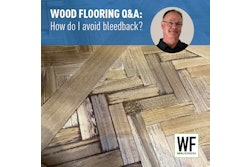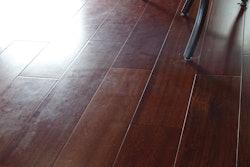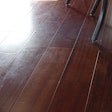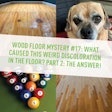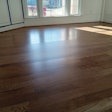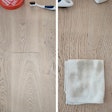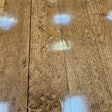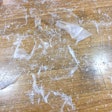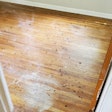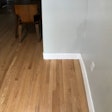The Problem
I recently was asked to take a look at a floor that had a significant amount of swirl marks after a screen and recoat. The floor in question was a factory-finished product that was approximately one and-a-half years old. It was solid red oak strip. The problem came about when the new homeowners moved into the home. During the move, the movers unknowingly damaged the floor. The moving company contracted a retail store to recoat the floor, and the retail store subcontracted the work to a local floor contractor who screened and recoated the floor.
When the homeowners returned to their house and saw the floors, they were dismayed. In their words, the floor looked like it had spider webs in the finish. At this point, the homeowners called the retail store to look at the floor. The retail store called the floor contractor, and he returned to the job. Once he saw it, he realized he had a larger problem than before. The worried contractor then called me to see if I could give him advice on how to fix the problem without the hassle and expense of resanding the entire floor.
The Procedure
The floor contractor approached this job in the same manner in which he approached every screen and recoat in the past. But once he started to screen the floor with a well-worn 120-grit screen, he noticed that it did very little abrading. He then tried to use a new 120-grit screen. This resulted in inconsistent patches on the floor—some areas were well abraded, some were not. Fearing adhesion problems, he went to a new 100-grit screen. This finally removed the original problem—the scratches left by the movers. He vacuumed the floor and tacked the floor thoroughly. He then noticed an abundance of swirl marks. However, he went ahead with applying a coat of oil-based polyurethane, figuring it would sufficiently fill or hide the marks.
The Cause
With a little investigative research, I discovered the floor in question was an aluminum oxide product. Once the deep scratches were put into the floor, the semi-gloss finish was not able to hide or cover them. In fact, there were so many swirl marks, the finish only magnified the problem. Another coat would only make the problem worse. Had he used a matte or satin finish, the swirl marks would not have been as noticeable. But the homeowners in this case insisted on a semi-gloss sheen.
How to Fix the Floor
At this point, we were dealing with a known topcoat—an oil-modified polyurethane semi-gloss finish. I suggested a two-step sanding process. First,we used a maroon pad with sanding strips. This softened up the swirl marks left behind from the previous screening. We vacuumed the floor, and then we buffed it again with another maroon pad with sanding strips, moving up to the next highest grit to ensure a uniform appearance without aggressive marks. We then vacuumed, tacked and coated the floor with the same finish. The end result was a nice-looking floor—with no swirl marks.
In the Future
Some major finish manufacturers offer coating systems designed for use specifically over aluminum oxide floors. If you aren't familiar with them, ask your local distributor. If the contractor had used one of these systems, he would not have had this problem.
It pays to know the history of an existing floor before you attempt to coat over it. Get as much information as you can, including the maintenance history. What type of cleaners have been used and how often? Are the homeowners the original owners of the floor? Has the floor ever been recoated? What type of finish is on the floor? If it is a prefinished floor, as in this case, try to find out who manufactured the floor and how old it is. Are there still scrap pieces in the home? Do your homework beforehand. It will cost a lot less in the long run. Like my grandmother always taught me,an ounce of prevention is worth a pound of cure. Why don't we listen?
Take the time to keep up on new techniques and materials, as they are always changing. Never think that the way we do floors today is the way we will always do floors. Times change, and so do the products we use. Yes, "generation education"is something we should all be proud of. But trust me, I grew up doing floors different than my great grandfather, grandfather and my father did, and the way I do floors continues to change. If there is a class available on something new to you, try to attend. Flooring manufacturers, finish manufacturers and the NWFA frequently offer training seminars throughout the country. Education is the one key you cannot do without. Above all, the most important advice I can give is to stick with the manufacturer's recommendations. Let them be the chemist—don't make your customer's floor the guinea pig.














